
![]() St-Gilles
is located in the Gard
département of the Languedoc-Roussillon,
not far from Provence, on the northern limits of the the
Camargue.
is the ancient seat of the The
House of Toulouse. It is named after Saint Gilles
(
St-Gilles
is located in the Gard
département of the Languedoc-Roussillon,
not far from Provence, on the northern limits of the the
Camargue.
is the ancient seat of the The
House of Toulouse. It is named after Saint Gilles
(![]() Saint Giles)
a Greek saint alleged to have lived during the dark ages.
The town of Saint-Gilles lies between Arles (15 km) and
Nîmes
(16 km). It is now important because of its 12th century
church, one of the most important Romanesque buildings in
the Midi, surviving from the Abbey of St Gilles.
Saint Giles)
a Greek saint alleged to have lived during the dark ages.
The town of Saint-Gilles lies between Arles (15 km) and
Nîmes
(16 km). It is now important because of its 12th century
church, one of the most important Romanesque buildings in
the Midi, surviving from the Abbey of St Gilles.
- The Town of St Gilles
- The Abbey of St Gilles
- Photographs of St Gilles (Abbey, Town and Saint)
- The Legendary person called St Gilles
- The Noble House of St Gilles
The Town of St-Gilles
The town was once a major commercial centre and the fourth largest pilgrimage destination. It grew up around an abbey, and was the original seat of a family who became the Counts of Toulouse. It was enormously afflouent in the Middle Ages, largely because of the pilgrim trade. Pilgrims on their way from Italy to Compostella in Spain stopped at St Gilles on the Via Tolosana on their way from Arles to Saint-Guilhem-le-Désert and Toulouse, sometimes taking a detour to Saintes-Maries-de-la-Mer.
Saint-Gilles was the birthplace of Guy Foulques, Pope Clement IV (died 1268). The house where he was born is now a museum of the archaeology, ethnology and ornithology of the Camargue.
It was on the River Rhône near to St-Gilles, after a rancorous meeting with Raymond VI, that the Cistercian Pierre de Castelnau was murdered on 15th January 2008, providing Pope Innocent III, with a pretext for the Albigensian Crusade.
The Nîmes-Arles-Camargue Airport, sometimes called Garons Airport, is located in the St-Gilles commune.
The Master of Saint Gilles is an anonymous Late Gothic painter. The artist was given the title as the first work attributed to him were two works with Saint Giles as the subject now in the National Gallery, London.
From the parvis (the open space) in front of the church (Place de la République) a narrow lane leads to the Place de l'Olme with its Maison Romane (Romanesque House) adjoining the tourist office. It has capitals decorated with figures on its first and second stories. It hoses a museum with an early Christian sarcophagus, relief fragments and a natural history collection. From the hall on the second floor there is a view across the roofs of St-Gilles.

![]() An important pilgrim route, the Via Tolosana (marked in blue on the right) led through Arles, St-Gilles, Saint-Guilhem-le-Désert and Toulouse and crossed the Pyrenees to join other routes at Puenta-la-Reina, thence to Santiago along the Via Compostelana to Santiago de Compostela.
An important pilgrim route, the Via Tolosana (marked in blue on the right) led through Arles, St-Gilles, Saint-Guilhem-le-Désert and Toulouse and crossed the Pyrenees to join other routes at Puenta-la-Reina, thence to Santiago along the Via Compostelana to Santiago de Compostela.
Another route, the Regordane (marked in green), led from Le Puy-en-Velay to St-Gilles, by way of the Cévennes, Alès and Nîmes. Some pilgrims came only as far as St-Gilles, the fourth most important pilgimage destination in Europe. Others went on to Santiago de Compostela along the Via Tolosana possibly taking a detour to Saintes-Maries-de-la-Mer (While Compostela claimed the relics of St-James, Saintes-Maries-de-la-Mer claimed the relics of his mother, Mary) |
|
St-Gilles lies on the Canal Rhône-Sète, an extension to the Canal du Midi, built by Pierre-Paul Riquet a notable Languedoc resident. The Canal is popular for boating holidays and through France's extensive canal network provides a way to get to the Languedoc from the Atlantic Ocean, Northern France and Mediterranean Sea.
St Gilles has a land area of 153.73 km² (59.355 sq mi).
Its elevation above sea level is 0 m–116 m (avg. 7 m)
Population 12,000
INSEE 30258
Postal code 30800
Coordinates: 43 ° 40 ′ 43 ″ N 4 ° 25 ′ 54 ″ E
Abbey and Church
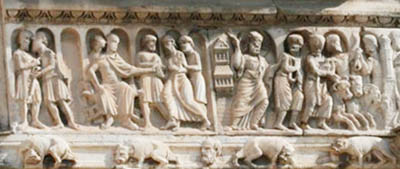
![]() The Benedictine monastery of Saint-Gilles was founded during the 7th century traditionally by a hermit called Saint Giles (
The Benedictine monastery of Saint-Gilles was founded during the 7th century traditionally by a hermit called Saint Giles (![]() Saint Gilles).
Saint Gilles).
The present church was erected in the 12th century as the abbey church. During the French Wars of Religion, Protestants (Huguenots) defended themselves within the abbey, which was severely damaged as a result. It was restored in the 17th century but damaged again during the French Revolution.

![]() The west front has three doorways and decorative figures (including the first detailed representation of the Passion in Western sculpture). The abbey church's west portal is among the most beautiful of the great Romanesque portals and a definitive example of the Provençal Romanesque.
The west front has three doorways and decorative figures (including the first detailed representation of the Passion in Western sculpture). The abbey church's west portal is among the most beautiful of the great Romanesque portals and a definitive example of the Provençal Romanesque.
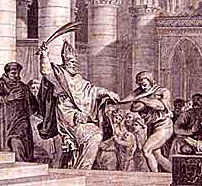
![]() The interior of the church, with three aisles but no transepts, is characterized by Gothic forms which are unusually broad for this period. The shrine of Saint Gilles, located in the crypt of the church, was once a place of pilgrimage for women wishing to become pregnant. It is supposed to contain the relics of the saint. The entrance to the crypt is on the right of the facade.
The interior of the church, with three aisles but no transepts, is characterized by Gothic forms which are unusually broad for this period. The shrine of Saint Gilles, located in the crypt of the church, was once a place of pilgrimage for women wishing to become pregnant. It is supposed to contain the relics of the saint. The entrance to the crypt is on the right of the facade.
It was here that the Cistercian Pierre de Castelnau, whose murder provided a pretext for the Albigensian Crusade, was buried; and here that Raymond VI, Count of Toulouse, was publicly flogged as part of his punishment before his excommunication was lifted. He
suffered himself, on the 18th of June, 1209, to be conducted into the church of St. Gilles with a cord about his neck; and there receive the discipline upon his naked shoulders before the altar .

![]()

![]() The former abbey church was listed in 1998 among the UNESCO World Heritage Sites, as part of the Routes of Santiago de Compostela in France, one of several World Heritage sites in the Languedoc.
The former abbey church was listed in 1998 among the UNESCO World Heritage Sites, as part of the Routes of Santiago de Compostela in France, one of several World Heritage sites in the Languedoc.
To the left of the church facade a lane leads to the ruins of the old choir, destroyed in the 17th C. Here is the Vis de St- Gilles (Screw of St Gilles or spiral staircase of st-Gilles), a staircase dating from the 12th C, now a free-standing spiral staircase of cantilevered stone steps. It is a masterpiece of the stonemason's art. Also to be seen here are the remains of the old apse.
Saint Gilles Photographs
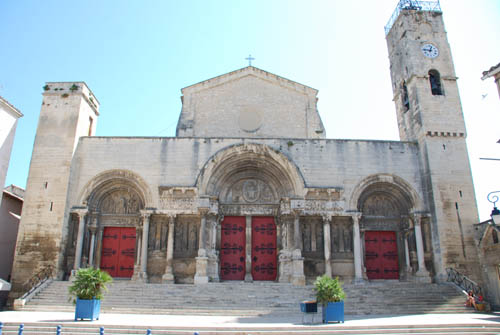 |
||
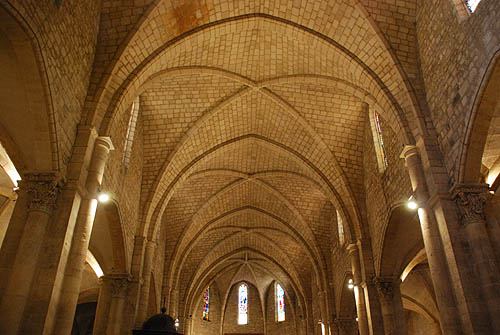 |
||
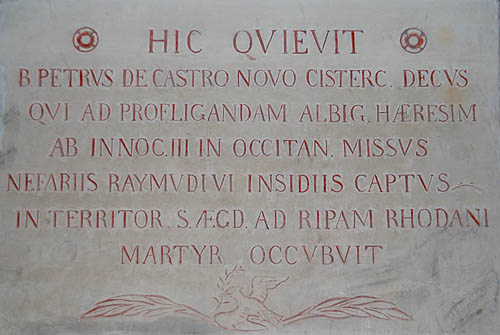 |
||
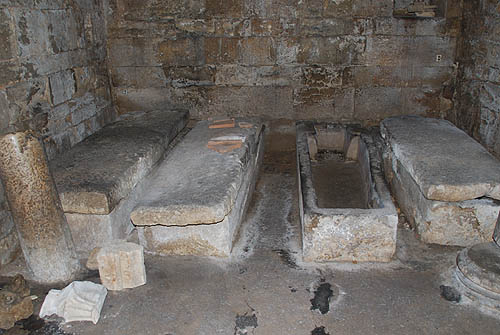 |
||
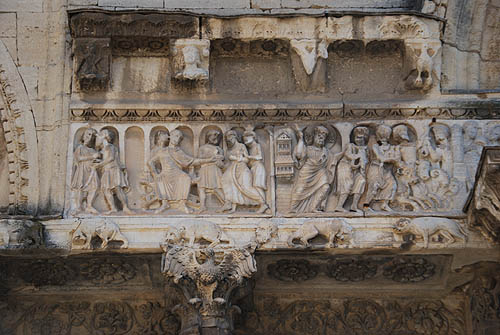 |
||
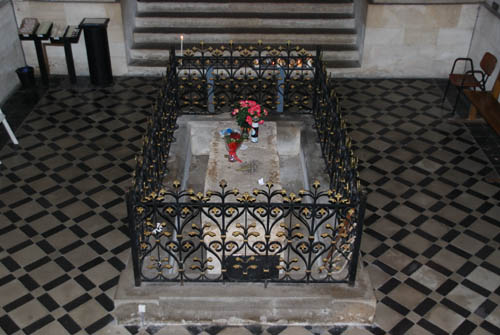 |
||
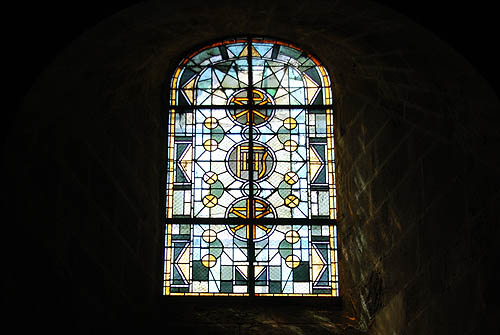 |
||
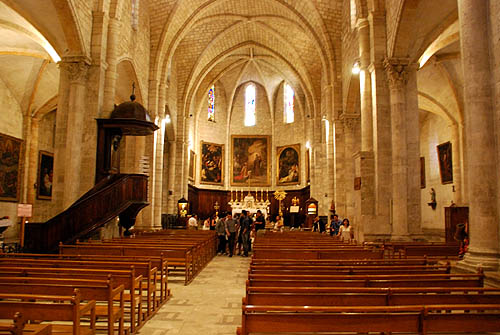 |
||
 |
||
 |
||
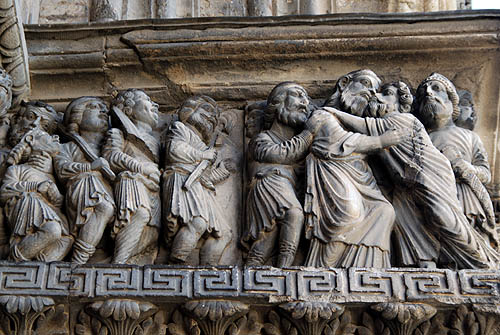 |
||
 |
||
 |
||
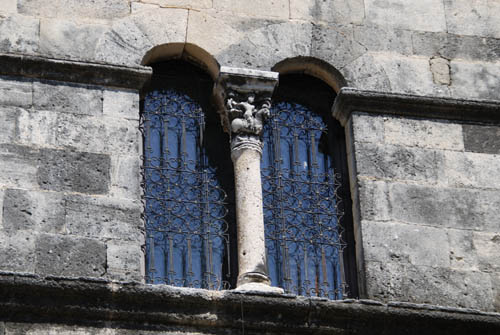 |
||
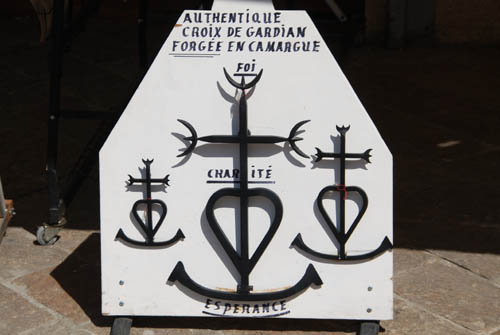 |
||
 |
||
 |
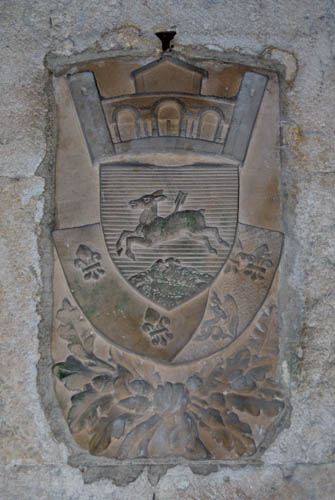 |
|||
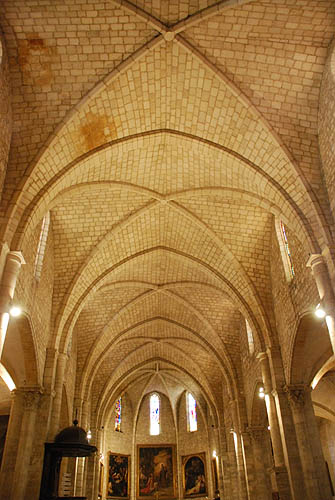 |
 |
|||
 |
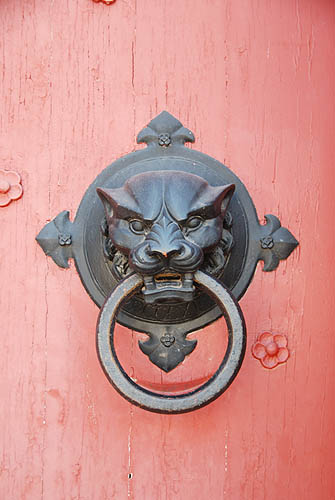 |
|||
 |
 |
|||
 |
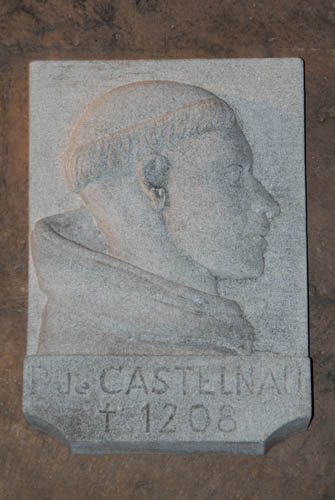 |
|||
 |
||||
The Original Saint Gilles (saint Giles)
Saint Gilles was a Christian hermit saint. according to tradition he lived c. 650 - c. 710, though there is no reliable evidence that he existed, and the anachronistic details of his life suggest that, like most saints, he was invented or adapted from a pagan historical character. He was supposed to be the son of King Theodore and Queen Pelagia of Athens. He is known as Ægidius or Egidius in Latin, Egidio in Italian, Gèli in Occitan, and Giles in English. His supposed tomb in the abbey of St-Gilles became a place of pilgrimage and a stop on the road that stretched from Arles to Santiago de Compostela, part of the pilgrim Way of St. James.
As a hermit Gilles is supposed to have lived near the confluence of the the River Gard (or Gardon) and the River Rhône. Two incidents in his life were often depicted in art.

![]()

 The Miracle of Saint Gilles. His early history, as given in Legenda Aurea, links him with Arles, but he withdrew into the forest near Nîmes, where he spent many years. His sole companion was a hind, who sustained him on her milk. His hermitage was eventually discovered by the king's hunters who pursued the hind to its place of refuge.
The Miracle of Saint Gilles. His early history, as given in Legenda Aurea, links him with Arles, but he withdrew into the forest near Nîmes, where he spent many years. His sole companion was a hind, who sustained him on her milk. His hermitage was eventually discovered by the king's hunters who pursued the hind to its place of refuge.
An arrow shot at the deer wounded the saint instead. (As a result of this he became patron of cripples (Hence the name of Saint Giles Cripplegate in London). The king, Wamba - a wildly anachronistic Visigoth king - took to Gilles and built him a monastery in his valley, Saint-Gilles-du-Gard, which he placed under the Benedictine rule. According to legend, Giles died here in the early part of the eighth century, accompanied by the usual selection of legendary miracles.

![]() The Mass of Saint Gilles. The tenth-century Vita sancti Aegidii recounts that as Giles was celebrating mass to pardon the emperor Charlemagne's sins, an angel deposited upon the altar a letter outlining a sin so terrible that Charlemagne had never dared confess it. Several Latin and French texts, including Legenda Aurea also refer to this intriguing "sin of Charlemagne".
The Mass of Saint Gilles. The tenth-century Vita sancti Aegidii recounts that as Giles was celebrating mass to pardon the emperor Charlemagne's sins, an angel deposited upon the altar a letter outlining a sin so terrible that Charlemagne had never dared confess it. Several Latin and French texts, including Legenda Aurea also refer to this intriguing "sin of Charlemagne".
These stories and a later text, Liber miraculorum sancti Aegidii ("Book of the miracles of Saint Giles") helped reinforce the flow of pilgrims to the abbey. The abbey remained the centre of his cult, even after a rival body of Saint Gilles appeared at Toulouse. His cult spread through the Languedoc and the rest of Europe in the Middle Ages. Churches and monasteries are still dedicated to him in France, Spain, Germany, Poland, Hungary, Slovakia, and Great Britain.
In 1562 the supposed relics of the saint were transferred to Toulouse to save them from the Huguenots, during the wars of Religion, after which the level of pilgrimages declined. With the restoration of a great part of the relics to the abbey of Saint-Gilles-du-Gard in 1862, and the discovery of his supposed tomb there in 1865, pilgrimages recommenced.

![]()

![]() Besides Saint-Gilles-du-Gard, at least nineteen other towns bear his name. As well as Saint-Gilles, cities that possess relics of St. Giles include Toulouse and other French cities; Antwerp, Bruges and Tournai in Belgium; Cologne and Bamberg in Germany; Rome and Bologna in Italy, Prague and Gran. Gilles is also the patron saint of Edinburgh, Scotland, where St. Giles' Cathedral is a prominent landmark.
Besides Saint-Gilles-du-Gard, at least nineteen other towns bear his name. As well as Saint-Gilles, cities that possess relics of St. Giles include Toulouse and other French cities; Antwerp, Bruges and Tournai in Belgium; Cologne and Bamberg in Germany; Rome and Bologna in Italy, Prague and Gran. Gilles is also the patron saint of Edinburgh, Scotland, where St. Giles' Cathedral is a prominent landmark.
In church art he is depicted with his symbol, the hind. His emblem is also an arrow. Gilles is one of the Fourteen Holy Helpers, and the only non-martyr, initially invoked as protection against the Black Death. Gilles is depicted with other Holy Helpers on the right (in the lower left with a hind). He is the patron saint of cripples. His feast day is September 1.
The Noble House of St-Gilles
The House of St-Gilles was one of the most powerful and influential of the Middle Ages with an ancient Lineage and an impressive Genealogy. The family were in dependant sovereigns whose titles included Count of Toulouse, Duke of Narbonne, Count of Quercy, Rouergue and Saint-Gilles; Count of Agen (Aquitaine); Marquis of Provence (Holy Roman Empire), Count of Melgueil (Papacy) - independent sovereigns in all but name.
Many of the family were Crusaders, including Raymond IV, the most senior leader of the successful First Crusade. The family also founded the County of Tripoli, where the name Saint-Gilles was rendered phonetically as Sanjil. Raymond of St Gilles lent his name to St. Gilles Castle (Arabic: Qala’at Sanjil) in Tripoli now in the Lebanon. Sinjil is also a West Bank Palestinian village and a popular boy's name (Exceptionally for crusaders, the House of Saint Gilles was respected by Moslems, Jews and Christians alike).
Under Raymond VI and Raymond VII the House of Saint Gilles was destroyed by a papal crusade against the people of the Languedoc, the so-called Albigensian Crusade or Cathars Wars in the thirteenth century. The family's historic lands were annexed to France after the war, but their heraldic device, the Cross of Toulouse is still widely used everywhere in the Languedoc.
 |
 |
 |
 |
 |
 |
 |
|---|






